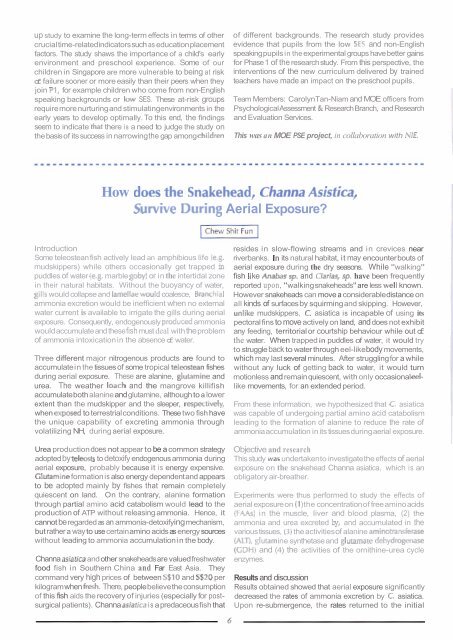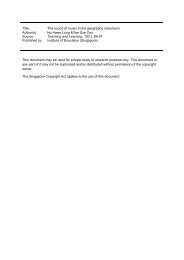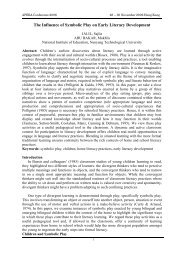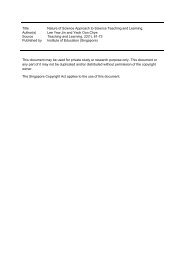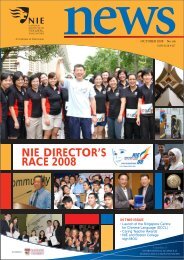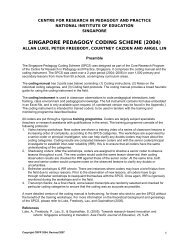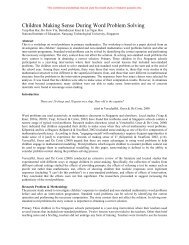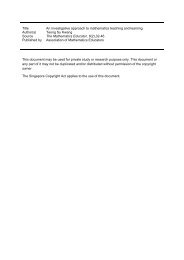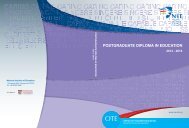Future EBuczttIomI Research: The - NIE Digital Repository - National ...
Future EBuczttIomI Research: The - NIE Digital Repository - National ...
Future EBuczttIomI Research: The - NIE Digital Repository - National ...
Create successful ePaper yourself
Turn your PDF publications into a flip-book with our unique Google optimized e-Paper software.
up study to examine the long-term effects in terms of othercrucial time-related indicators such as education placementfactors. <strong>The</strong> study shaws the importance of a child's earlyenvironment and preschool experience. Some of ourchildren in Singapore are more vulnerable to being at riskof failure sooner or more easily than their peers when theyjoin PI, for example children who come from non-Englishspeaking backgrounds or low SES. <strong>The</strong>se at-risk groupsrequire more nurturing and stimulating environments in theearly years to develop optimally. To this end, the findingsseem to indicate that there is a need to judge the study onthe basis of its success in narrowingthe gap among chiIdrenof different backgrounds. <strong>The</strong> research study providesevidence that pupils from the low SES and non-Englishspeaking pupils in the experimental groups have better gainsfor Phase 1 of the research study. From this perspective, theinterventions of the new curriculum delivered by trainedteachers have made an impact on the preschool pupils.Team Members: Carolyn Tan-Niam and MOE officers fromPsychological Assessment & <strong>Research</strong> Branch, and <strong>Research</strong>and Evaluation Services.This was an MOE PSE project, in collaboration with <strong>NIE</strong>.Howdoes the Snakehead, Channa Asisfica,Survive During Aerial Exposure?IntroductionSome teleostean fish actively lead an amphibious life (e.g.mudskippers) while others occasionally get trapped inpuddles of water (e.g. marble goby) or in the intertidal zonein their natural habitats. Without the buoyancy of water,gills would collapse and lamellaewould coalesce, Branchialammonia excretion would be inefficient when no externalwater current is available to irrigate the gills during aerialexposure. Consequently, endogenously produd ammoniawouldaccumulate and thesefish must deal withtheproblemof ammonia intoxication in the absence of water.Three different major nitrogenous products are found toaccumulatein the tissues of some tropical teleostean fishesduring aerial exposure. <strong>The</strong>se are alanine, glutamine andurea. <strong>The</strong> weather loach and the mangrove killifishaccumulateboth alanineandglutamine, although to a lowerextent than the mudskipper and the sleeper, respectively,when expod to terrestrialconditions. <strong>The</strong>se two fish havethe unique capability of excreting ammonia throughvolatilizing NH, during aerial exposure.Urea productiondoes not appear to be a common strategyadoptedby teleosts to detoxify endogenous ammonia duringaerial exposure, probably because it is energy expensive.GIutamine formation is also energy dependentand appearsto be adopted mainly by fishes that remain completelyquiescent on land. On the contrary, alanine formationthrough partial amino acid catabolism would lead to theproduction of ATP without releasing ammonia. Hence, itcannot be regarded as an ammonia-detoxifyingmechanism,but rather a way to use certainamino acidsas energy sourceswithout leading to ammonia accumulation in the body.Channa ajafica andother snakeheadsare valuedfreshwaterfood fish in Southern China and Far East Asia. <strong>The</strong>ycommand very high prices of between S$10 and S$20 perkilogramwhen fresh. <strong>The</strong>re, peoplebelievetheconsumptionof this fish aids the recovery of injuries (especially for postsurgicalpatients). Channa asiatica is apredaceousfish thatresides in slow-flowing streams and in crevices nearriverbanks. In its natural habitat, it may encounterbouts ofaerial exposure during the dry seasons. While "walking"fish Ii ke Anabas sp. and Clariag sp. have been frequentlyreported upon, "walkingsnakeheads" are less we1 l known.However snakeheads can move a considerabledistance onall kinds of surfacesby squirmingand skipping. However,unIike mudskippers, C. asiatica is incapable of using itspectoral fins to move actively on land, and does not exhibitany feeding, territorialor courtship behaviour while out ofthe water. When trapped in puddles of water, it would tryto struggleback to water through eel-likebody movements,which may last several minutes. After strugglingfor a whilewithout any luck of getting back to water, it would turnmotionless and remainquiescent, with only occasional eellikemovements, for an extended period.From these information, we hypothesized that asiaticawas capable of undergoing partial amino acid catabolismleading to the formation of alanine to reduce the rate ofammonia accumulation in its tissues during aerial exposure.Objective and researchThis study was undertakento investigate the effects of aerialexposure on the snakehead Channa asiatica, which is anobligatory air-breather.Experiments were thus performed to study the effects ofaerial exposure on (1)the concentration of free amino acids(FAAs) in the muscle, Iiver and blood plasma, (2) theammonia and urea excreted by, and accumulated in thevarious tissues, (3) the activities of alanine aminotransferase(ALT), glutam ine synthetase and gl utamate dehydrogenase(CDH) and (4) the activities of the ornithine-urea cycleenzymes.Results and discussionResults obtained showed that aerial exposure significantlydecreased the rates of ammonia excretion by C. asiatica.Upon re-submergence, the rates returned to the initialC.


